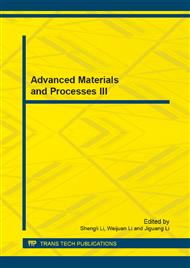[1]
Ding, Y., and J. A. Gear, Spalling depth prediction model, Wear 267. 5 (2009) 1181-1190.
DOI: 10.1016/j.wear.2008.12.064
Google Scholar
[2]
Santus, C., et al, Surface and subsurface rolling contact fatigue characteristic depths and proposal of stress indexes, Int. J. of Fatigue 45 (2012)71–81.
DOI: 10.1016/j.ijfatigue.2012.06.012
Google Scholar
[3]
Slack, Trevor S., Nihar Raje, A Review of Rolling Contact Fatigue, Journal of Tribology 131(2009) 041403-1.
Google Scholar
[4]
Lundberg, Gustaf, Arvid Palmgren, Dynamic Capacity of Rolling Bearings, Acta Polytech. Scand., Mech. Eng. Ser. 1 (1947)1–52.
Google Scholar
[5]
Miyashita, Yukio, et al, Subsurface Crack Propagation in Rolling Contact Fatigue of Sintered Alloy, JSME International Journal, Series A. 46 (2003)341-347.
DOI: 10.1299/jsmea.46.341
Google Scholar
[6]
Schlicht, H., E. Schreiber et al, Fatigue and Failure Mechanism of Bearings, Fatigue of Engineering Materials and Structures 1 (1986)85-90.
Google Scholar
[7]
Yu, Wei Kufi, and Tedric A. Harris, Fatigue Theory: Considerations of Failure Stress and Stressed Volume, Tribology transactions 44 (2001)11-18.
Google Scholar
[8]
Bernasconi, A., et al, An integrated approach to rolling contact sub-surface fatigue assessment of railway wheels, Wear 258. 7 (2005) 973-980.
DOI: 10.1016/j.wear.2004.03.044
Google Scholar
[9]
Ekberg, Anders, Elena Kabo, Hans Andersson, Predicting rolling contact fatigue of railway wheels13th International Wheelset Congress in Rome, (2001)17–21.
Google Scholar
[10]
Kabo, Elena, Roger Enblom, Anders Ekberg, A simplified index for evaluating subsurface initiated rolling contact fatigue from field measurements , Wear 271. 1 (2011)120-124.
DOI: 10.1016/j.wear.2010.10.045
Google Scholar
[11]
Jalalahmadi, Behrooz, Farshid Sadeghi, A Voronoi finite element study of fatigue life scatter in rolling contacts , Journal of tribology 131. 2 (2009).
DOI: 10.1115/1.3063818
Google Scholar
[12]
Johnson K L, Strength of surfaces in rolling contact, J. of Mech. Eng. Sci. 203 (1989)151-63.
Google Scholar
[13]
Johnson K. L, Contact mechanics, Cambridge University Press, (1985).
Google Scholar
[14]
Pook L P, Metal fatigue: what it is, why it matters, Springer, (2007).
Google Scholar
[15]
Maddox, S. J, The effect of mean stress on fatigue crack propagation a literature review, International Journal of Fracture11. 3 (1975) 389-408.
Google Scholar
[16]
Kujawski, D., F. Ellyin, A unified approach to mean stress effect on fatigue threshold conditions, Int. J. of Fatigue 17. 2 (1995)101-106.
DOI: 10.1016/0142-1123(95)95888-n
Google Scholar
[17]
Zhang, Jianyu, et al, Tension–torsion high-cycle fatigue failure analysis of 2A12-T4 aluminum alloy with different stress ratios, Int. J. of Fatigue 33. 8 (2011) 1066-1074.
DOI: 10.1016/j.ijfatigue.2010.12.007
Google Scholar
[18]
Nalla, Ravi K., et al, On the in vitro Fatigue Behavior of Human Dentin: Effect of Mean Stress , Journal of dental research 83. 3 (2004) 211-215.
DOI: 10.1177/154405910408300305
Google Scholar
[19]
Norman E. D., Mean stress effects in stress-life and strain-life fatigue, SAE Technical Paper, (2004).
DOI: 10.4271/2004-01-2227
Google Scholar
[20]
Murakami, Y., et al, Effect of mean stress on the fatigue strength of high-strength steels containing small defects or nonmetallic inclusions, TRANS. JAPAN SOC. MECH. ENG. (SER. A) 56. 525 (1990)1074-1081.
DOI: 10.1299/kikaia.56.1074
Google Scholar
[21]
Sun, Chengqi, Youshi Hong, Correlation of crack growth rate and stress ratio for fatigue damage containing very high cycle fatigue regime , Theoretical and Applied Mechanics Letters 2. 3 (2012)031004-031004.
DOI: 10.1063/2.1203104
Google Scholar
[22]
Yukitaka Murakami: Metal fatigue: effects of small defects and nonmetallic inclusion, Elsevier Science, (2002).
Google Scholar
[23]
Kudish I I, Contact Fatigue of Rough Elastic Surfaces in Two-Dimensional Formulation, Journal of tribology 133 (2011) 031405-1-9.
DOI: 10.1115/1.4004346
Google Scholar
[24]
Šraml M, Flašker J, Potrč I, Numerical procedure for predicting the rolling contact fatigue crack initiation, Int.J. of Fatigue 25(2003) 585-595.
DOI: 10.1016/s0142-1123(03)00019-7
Google Scholar


